Currently in the UK we are experiencing a high influx of jellyfish (and therefore jellyfish stings ) to our coastline. Although the majority are not dangerous, some are, so here’s our guide to jellyfish treatment – for both ourselves as well as our dogs.
Before we go any further, the advice below in no way mentions (and in fact would certainly discourage) us from urinating on the casualty! So, now we have that out of the way, please read on.
Jellyfish have tentacles and its these tentacles that do the damage. They are covered with nematocysts, known as stinging cells, which have a variety of functions including sticking to surfaces and wrapping around objects, penetrating surfaces or secreting proteinaceous toxins.
Prevention
If you think there is any chance of your dog coming into contact with jellyfish whilst on a swim, they need some protection. The tentacles of a jellyfish will sting as they come into contact with the skin – its not the pressure of touching that initiates the sting, but rather the chemical on the skin (this is why divers in and around Australia for example will usually wear tights (pantyhose) to try to protect their bare skin. Our dogs then are basically more safe than we are although we can spread petroleum jelly on any exposed skin, including the footpads, abdomen, nose, testicles, and eye rims to keep the venom from penetrating to the skin.
Signs & Symptoms:�
Below are listed the most comon signs and symptoms of a jellyfish sting although it is important to note that only some and not all may be present.
* Heavy, very itchy rash with burning sensation.
* Nausea
* Vomiting
* High blood pressure follows
* Fever
* Confusion
* Shock
* Heart and respiratory problems
* Death
N.B. Jellyfish stings can react differently based upon the species they belong to.
——————————————————————————————————–
- For the vast majority of jellyfish stings (on humans or on our dogs for that matter), treatment would be to soak or rinse the area in vinegar for 15-30 minutes to stop the nematocysts from releasing their toxins. If you do not have vinegar available, rinse in sea water or 70% alcohol.
- Do not use fresh water as this will cause toxins to be continued to be released.
- Do not rub the area as this will irritate the area still further.
- Wear gloves to remove tentacles or, if you dont have any, use a shell, a stick or a pair of tweezers. DO NOT touch the tentacles with your bare hands, even if the tentacle is no longer attached to the jellyfish itself.
- Make a paste of baking soda to apply to the area or you can use shaving cream.
- Shave the area with a razor or credit card to remove any adherent nematocysts.
- Reapply vinegar or alcohol. The shaving cream or paste prevents nematocysts that have not been activated from releasing their toxin during removal with the razor.
- Rinse stings to the eye stings with saline solution readily found in first aid kits for both humans and canines.
- For stings around the eyes, take a towel and soak it in vinegar the carefully dab the skin around the eyes ensuring that you Do Not place vinegar directly in the eyes.
- For stings to the mouth itself, we can use 1/4 strength vinegar. Simply mix ¼ cup of vinegar with ¾ cup of water and use a medicine syringe to irrigate the mouth. Do not allow the dog to drink or swallow the solution (for humans, gargle and spit out the solution).
- Monitor for signs of shock and be ready to commence CPR if required.
- Transport to your Vet ASAP.
——————————————————————————————————–
- Seek medical assistance immediately if you are stung by a box jellyfish.
- While you are waiting for medical help, and before attempting to remove the tentacles, flood the area with vinegar to soak the tentacles for 10 minutes or more , or until medical help arrives.
- Keep as still as possible.
- If you do not have any vinegar available, soak with salt water NOT fresh water
——————————————————————————————————–
Vinegar is the correct treatment for anything except the Portugese Man O War (commonly called bluebottles). Portugese Man O War are usually found in warmer waters and as such I think it would be unlikely to find them in the UK.
However, should you come in to contact with a Man O war, the treatment would be hot water, followed by ice. It is said that water of a temperature of 102 degrees will be helpful but that of 120 degrees would be better. Therefore, as most of us rarely have a thermometer to hand, it is suggested that asking the casualty to put their limb in as hot water as they can bare and then gradually raising the temperature is the best way to achieve this.
N.B. Please be sure not to burn your casualty by using water that is of too high a temperature.
Specifically related to the Barrel Jellyfish
Surprisingly solid large jellyfish. The bell is shaped like a dome and has a ghost white colour with purple/blue lobes around the margin. Eight solid oral-arms that resemble a cauliflower. No tentacles.
Size:
Up to 1m in diameter. We have measured a barrel jellyfish of 80 cm in diameter and weighing 35 kg!
Distribution:
Forms dense aggregations in coastal areas (Rosslare, Tremadoc and Carmarthen Bays) during summer months. Some individuals sighted or caught in the Irish Sea and off the South coast of Ireland during the winter.
Sting:
No tentacles but can cause irritation.

